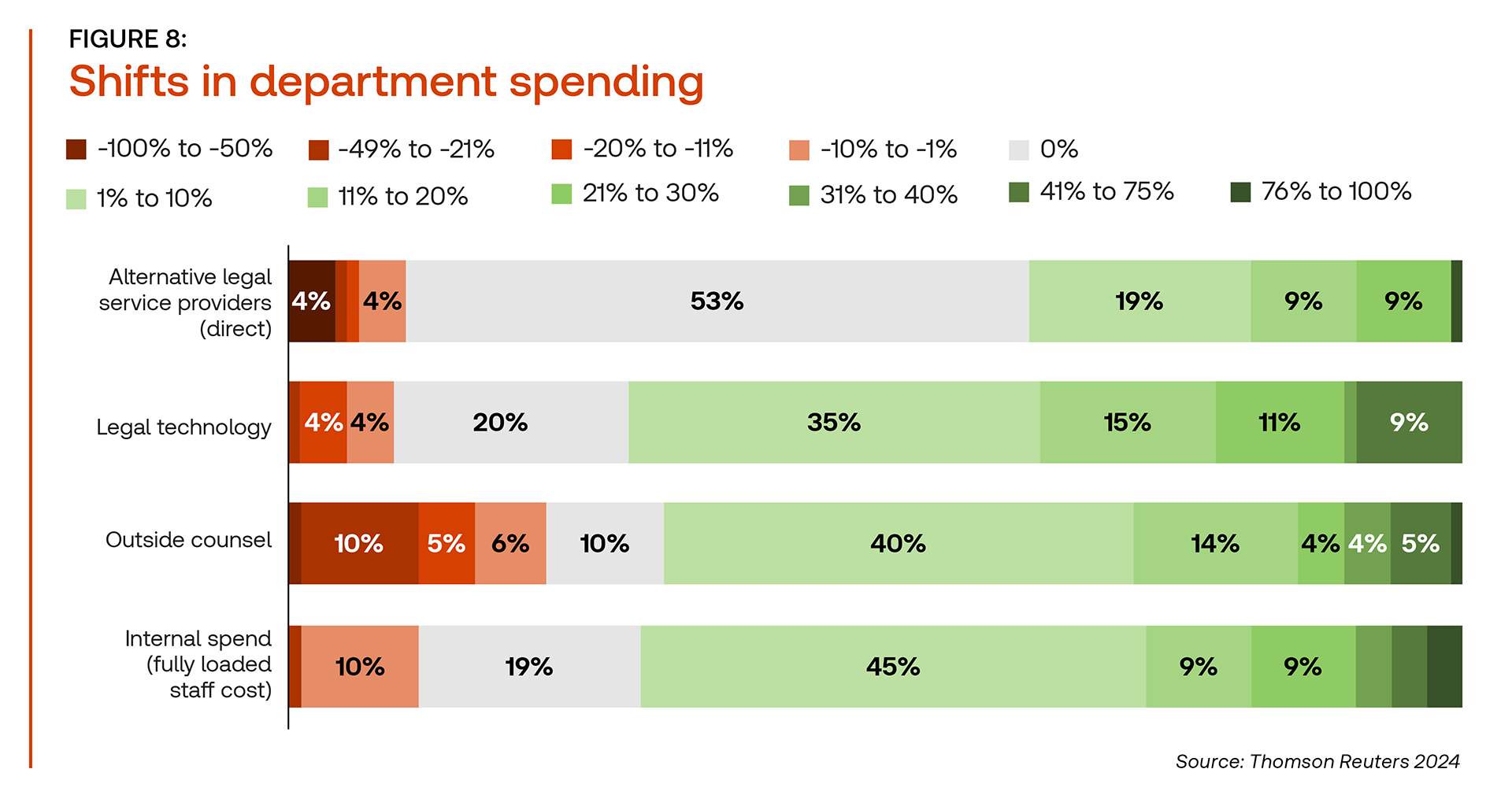Most corporate law departments report increasing matter volumes and are looking to leverage technology as a means to simplify their workflows; however, budgetary realities may pose additional challenges for those departments looking to upgrade their tech stack
Survey respondents from almost eight in 10 (79%) corporate law departments report an increase in the volume of legal matters their department is handling in just the past year, according to the Thomson Reuters Institute’s recently released 2024 Legal Department Operations Index (LDO Index) report. This reality — coupled with the rapid growth of law firm billing rates (6.5% on average through the midpoint of this year) and a desire to bring more work in-house as a cost-saving measure — has may department leaders looking for ways to increase their in-house capacity.
Yet, for most in-house legal teams, increased capacity is not coming by way of more attorneys hired to share the workload. In fact, two-thirds of respondents said their law departments had reported flat or declining attorney headcount. Likewise, as corporate general counsel (GCs) have become increasingly attuned to issues of attorney well-being and the potential for burnout, the challenge of increasing matter volumes likely won’t be solved by simply expecting the existing in-house team to shoulder more of the load.
The technology solution
To address this dilemma, may GCs are looking to technology to help them simplify workflows and increase their team’s capacity. In fact, 75% of survey respondents said their corporate law departments are placing a high priority on using technology to simplify current processes and manual workflows. By streamlining how work gets done, many GCs hope to remove lower-value tasks from regular workflows so that their teams have the ability to take on more high-value work.
Many departments have already begun these efforts, the report shows. More than six in 10 respondents said their law departments had made greater use of legal technology tools over the past year.
At the same time, however, the portion of the budget earmarked for legal technology may not be keeping up with these increased tech needs. Only 36% of respondents in the LDO Index said they saw an increase in their legal department technology budgets. In fact, nearly half said their technology budget was flat, and 9% said that their technology budget had actually decreased.
The desire and use case for new technology is evident in the trends. However, it is not yet apparent in budget allocations.
This may be on the verge of shifting, however. A majority of respondents said that they anticipate an increase in their technology spend in the future, and a plurality (35%) said they expect a relatively modest increase of between 1% and 10%. However, a significant portion anticipate larger increases.

This raises an important question about exactly where law departments anticipate finding these extra funds. Notably, a sizeable portion of respondents said they anticipate some reduction in their outside counsel spend — money which could be reallocated internally.
Reducing outside spending
This reduction in outside counsel spend could well become a reality for many in-house law departments, even as law firm billing rates continue aggressive growth. First, many GCs have expressed a desire to shift toward greater use of alternative fee arrangements, a move which could help create budget predictability and favorability for clients while bringing costs in line with department budget needs. Second, many law departments have joined the trend of increased tiering of legal work, moving some work to lower-cost firms. For a GC, moving work from an Am Law 100 law firm to a Midsize law firm gives them the benefit of lower cost, despite the pace of growth in the Midsize firm’s rates themselves. Given Midsize firms lower overall rates, moving work to these firms still represents a potentially substantial cost savings for the GC.
It is also important to recognize that reductions in one budget area are not necessarily in proportion to an increase in another. For example, a 2% reduction in outside counsel spend, if reallocated completely to increased investment in legal technology, may well represent much more than a 2% increase in technology spend due to the differing levels of expenditure on outside counsel and internal technology. For example, if a hypothetical law department spends $100 on outside counsel and $20 on legal tech, moving $2 from outside counsel spend to legal tech would represent a 2% reduction in outside counsel spend, but a 10% increase in tech spend.
It seems certain that something needs to give for in-house counsel to be able to handle a seemingly inevitable increase in workload. And since the options of increased reliance on outside counsel or working the existing in-house team harder are both unpalatable for obvious reasons, the option to work smarter not harder seems the most logical choice.
The unanswered question, however, is whether companies will ultimately move to align their in-house law departments budgets with their stated needs for increased technological capability.
You can download a full copy of the Thomson Reuters Institute’s 2024 Legal Department Operations Index report here.







